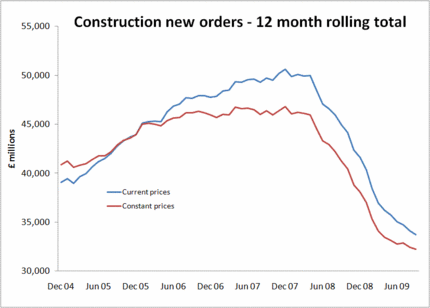Orders figures continue to point to a rougher road ahead
For those poring over the latest new orders figures released today to find guidance on the future of construction activity I suspect there is something for the optimists, but rather more for the pessimists.
It must be said that trying to discern sensible insight from examining the orders figures month by month is probably as fruitful as peering and prodding hourly at the scab on a grazed knee to see how it’s healing. You more or less know how long it will take to heal – a few days – but that doesn’t stop you looking.
Anyway the latest fare came out from the ONS today and it shows construction orders continuing on the predictable decline downward at a pretty predictable rate.

The optimists will no doubt read stability into the fact that the data suggests total orders for new work over the past three months matches the previous three months. The pessimists will note that order books will be shrinking rapidly, given that the level of orders on a 12-month-rolling basis is down 22% on a year ago.
Meanwhile, the more statistically quizzical will be fretting over the deflators being used by the ONS to help convert orders in cash values into orders in volume terms.
For my money, the most we can sensibly say about the figures is that they hint at a slowdown in the rate of decline in new orders, helped by what appears to be a level of stability in the housing sector orders.
If the figures throw up anything new, they do seem to suggest sadly that the blip we saw in housing orders in the spring was very much a feature of the bounce back associated with the destocking process, rather than the start of an upswing.
That is to say, having stopped sites while they ran down stocks of unsold homes, house builders then had to restart the production line and this can cause a relatively sharp temporary upward surge as the process kicks back to life again albeit to feed output at a much lower level.
My suspicions are that there is insufficient confidence within the major house builders to turn up the volume by anything that much. Meanwhile many of the smaller players have disappeared or are hibernating.
Fears of a double-dip recession in the housing market stalk the boardrooms of house builders at present, despite the relatively improved level of sales and prices over the summer, which in part is down to a shortage of second-hand housing on the market.
Improvement in that market is likely to rest with the valiant efforts of the Homes and Communities Agency. And it is true to say that the public housing orders are fairly robust.
So, while we probably ought to see uplift in the coming months in orders and work on sites, there are plenty of downside risks that suggest we may end up seeing low-level flat-lining rather than growth.
The infrastructure figures do provide room for cheer, but if you pick the big long-term projects out of the pot, some of the sheen comes off the figures.
And orders for the public non-housing, non-infrastructure work continue to hold up. But that is to be expected, until, that is, we see the inevitable savage axing of public spending cutting chunks out of the workload.
Then there is the commercial sector. I am constantly reminded by those more ebullient than me of this or that project and this or that developer making signals about starting this or that new building.
But the truth is that we may have a long wait before we see significant improvement in orders in the commercial sector and an even longer wait before we see workloads improve on the ground.
It was the spring of 1993 when commercial orders began to rise during the previous construction downturn. It was two years later before we saw any discernable rise in output in the sector.
My real concern is that the revival in the private sector, particularly the private commercial sector, will be rather more delayed than would be useful given the impending decline we must expect in public sector spending. The result of that would be a longer and more pronounced recession.
And there is certainly little room for joy and hope on the wider economic front as today we see the Bank of England move to extend quantitative easing, suggesting more needs to be done to repair the damaged and highly fragile UK economy.